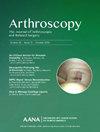No Clear Difference in Clinical Outcomes Between Knotted and Knotless Arthroscopic Bankart Repair: A Systematic Review
IF 4.4
1区 医学
Q1 ORTHOPEDICS
Arthroscopy-The Journal of Arthroscopic and Related Surgery
Pub Date : 2025-05-01
DOI:10.1016/j.arthro.2024.05.036
引用次数: 0
Abstract
Purpose
To analyze whether the arthroscopic Bankart repair using a knotless suture anchor has a better functional outcome than the conventional knot-tying Bankart repair.
Methods
A comprehensive literature search was done in the PubMed, Scopus, Embase, and Cochrane databases in May 2023. Studies comparing the clinical outcome of Bankart repair using knotless and knot-tying techniques were included in the study. In vitro, animal, and Level IV and V studies were excluded. The risk of bias in randomized controlled trials was calculated according to the RoB 2 tool, and for nonrandomized studies, Methodological Index for Non-Randomized Studies criteria were used. Statistical analysis was done using RevMan software.
Results
A total of 9 studies, including 2 randomized controlled trials and 7 nonrandomized comparative studies involving 720 patients, were included in the systematic review. The ROWE score ranged from 81.7 to 94.3 in the knot-tying group and 86 to 96.3 in the knotless group. Visual Analog Scale scores at the final follow-up ranged from 0.1 to 1.7 in the knot-tying group and 0.7 to 2.5 in the knotless group. The rate of redislocation, subluxation, and revision surgery in the knot-tying group ranged from 0% to 14.7%, 16.7% to 29.7%, and 1.6% to 17.6%, respectively, whereas that in the knotless group ranged from 2.4% to 23.8%, 7.4% to 22.2%, and 2.4% to 19%, respectively. The mean external rotation was 54° to 65° in the knot-tying group and 61° to 99° in the knotless group. The mean forward-flexion was 164 to 172 in the knot-tying group and 165 to 174 in the knotless group. Our subjective synthesis does not reveal any difference in the outcome between the 2 groups.
Conclusions
The available literature does not demonstrate a clear difference in functional outcomes, residual pain, and rate of complications as redislocation, subluxation, and revision surgery between Bankart repairs performed with knotted and knotless anchors.
Level of Evidence
Level III, systematic review of Level I to III studies
有结和无结关节镜下 Bankart 修复术的临床效果无明显差异:系统回顾
目的:本研究旨在分析使用无结缝合锚的关节镜Bankart修复术是否比传统的打结Bankart修复术具有更好的功能效果:方法:2023 年 5 月在 Pubmed、Scopus、Embase 和 Cochrane 数据库中进行了全面的文献检索。研究纳入了比较采用无结和打结技术进行 Bankart 修复术临床效果的研究。体外研究、动物研究以及 4 级和 5 级研究被排除在外。随机对照试验(RCT)的偏倚风险根据 RoB 2 工具进行计算,非随机研究则采用 MINORS 标准。统计分析采用 RevMan 软件进行:系统综述共纳入 9 项研究,包括 2 项 RCT 和 7 项非随机对比研究,涉及 720 名患者。打结组的 ROWE 评分在 81.7 到 94.3 之间,无结组的 ROWE 评分在 86 到 96.3 之间。最终随访时的 VAS 评分,打结组为 0.1 至 1.7 分,无结组为 0.7 至 2.5 分。打结组的再脱位率、半脱位率和翻修手术率分别为0至14.7%、16.7至29.7%和1.6至17.6%,而无结组分别为2.4至23.8%、7.4至22.2%和2.4至19%。打结组的平均外旋角度为 54 至 65 度,无结组的平均外旋角度为 61 至 99 度。打结组的平均前屈度为 164 至 172 度,无结组的平均前屈度为 165 至 174 度。我们的主观综合结果显示,两组之间没有任何差异:现有文献并未显示使用有结锚和无结锚进行Bankart修复术在功能结果、残余疼痛以及再脱位、半脱位和翻修手术等并发症发生率方面存在明显差异。
本文章由计算机程序翻译,如有差异,请以英文原文为准。
求助全文
约1分钟内获得全文
求助全文
来源期刊
CiteScore
9.30
自引率
17.00%
发文量
555
审稿时长
58 days
期刊介绍:
Nowhere is minimally invasive surgery explained better than in Arthroscopy, the leading peer-reviewed journal in the field. Every issue enables you to put into perspective the usefulness of the various emerging arthroscopic techniques. The advantages and disadvantages of these methods -- along with their applications in various situations -- are discussed in relation to their efficiency, efficacy and cost benefit. As a special incentive, paid subscribers also receive access to the journal expanded website.

 求助内容:
求助内容: 应助结果提醒方式:
应助结果提醒方式:


